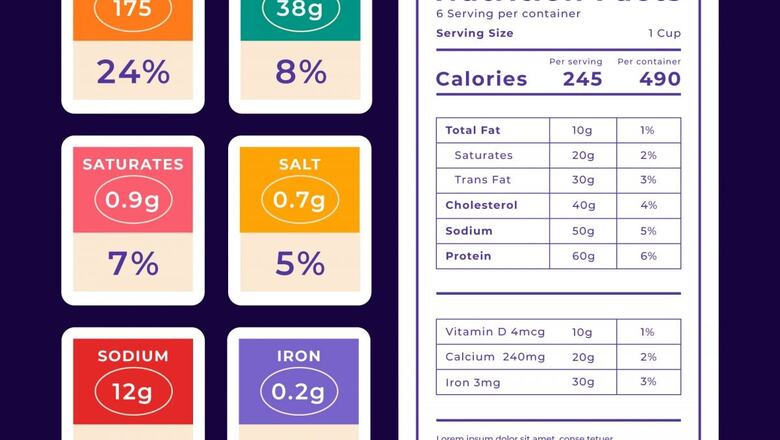
views
Do you check the details about the ingredients used, serving size, calories, and nutrient values such as fats, carbohydrates, and proteins on the back of a packet? We know some of you do that but some are still unversed with the marketing jargon of organic and healthy foods and fail to see the back of a package. It’s important to turn the package and read the nutrition label to make informed decisions about what we consume.
What is Nutrition labeling?
According to the WHO, “Nutrition labelling includes nutrient declarations, which should be mandatory for pre-packaged foods and for defined nutrients; and supplementary nutrition information, which includes front-of-pack labelling (FOPL). Effective nutrition labelling, including FOPL has been identified as one of the strategies that countries should use to address the growing global concern of unhealthy diets”.
Nutrition labeling helps us understand the nutrient content of the food we eat, which in turn allows us to make healthier choices and manage our overall health. It helps people with special dietary requirements, such as those with diabetes, allergies, or intolerances, to make safe food choices. Nutrition labeling plays a vital role in promoting healthy eating habits, and turning the package to read the label is a simple yet effective step towards making informed food choices.
The food industry does such amazing brand marketing, that we many a times pick up groceries and processed foods by simply seeing the colour of the pack from the shelves of a supermarket without even reading the name of the food product. So, what do you generally look out for on the cover of a packaged food? Is it the MRP, logos, health claims, manufacturing date/ use by date or more? The information provided to the consumers, on the front, back and sides of the package regarding the food which is inside the pack is called Food Labeling.
“It is very important to know how to read and understand food labels in order to understand what you are eating. Eating right is not just about making your calories count but also acquiring the essential nutrients in optimal amount for good health. Hence, it is important to know the nutritional value of the packaged foods that we eat every day,” says Meghana Pasi, Nutritionist, MyThali, Arogya World.
For eg. someone with kidney disease who needs to monitor his sodium, or someone with diabetes counting his carbs should read the label and know whether a certain food can fit in their diets or not. If someone is overweight, comparing the calorie content of various options allows them to choose a low-calorie, nutritious food to stay within their daily calorie goals.
Why do we need to turn the package?
“We should all try to avoid packaged foods as much as possible to be healthy. But it’s impossible today to avoid them completely because even a lot of healthy food staples are mostly available only in packaged forms in supermarket shelves in the modern urban environment. And just because a food comes in packaged form doesn’t automatically make it unhealthy- that’s why it’s crucial to be able to learn how to read and decipher food labels,” says Mugdha Pradhan, Functional Nutritionist, CEO and Founder, iThrive.
Don’t go by what’s printed on the front of the package because that is just marketing material which usually includes jargon like “natural” and “chemical-free” that actually doesn’t mean anything. Always check out the complete ingredients list at the back of the package. The nutrition content table is also helpful to check out the macronutrient breakup and sugar content.
“The ingredients list can be difficult to follow since it includes a lot of industrial names. A lot of this is actually by design- food manufacturers employ aliases to disguise harmful foods-there is an endless list of names and forms refined sugar can appear as- such as “invert syrup”, “corn syrup” and “barley malt”. Refined seed oils are called “vegetable oils” to appear healthy,” adds Pradhan.
It takes a little bit of digging around and research to decipher ingredients- lists but with a little experience you learn about the common culprits soon enough!
Also, just because a product says “organic” does not mean it is a certified organic product. Look for the organic certification label that shares details of the certification organization to verify if it’s certified organic.
Decoding Nutrition Labels:
Pasi suggests looking out for this information:
- List of Ingredients: Food materials are listed and in the order of its quantity — from highest to lowest amount of its presence in the food.
- Nutrient Facts Table:Number of servings and amount per servingTotal calories obtained from that servingTotal calories obtained from fats. The lesser the better.Fat, Cholesterol and Sodium should not be more than 5% of your Daily Allowance.The nutrients highlighted in the green are healthy (fiber, Vit A, C, Calcium, Iron). The higher the % of Daily values the better for health.
- Avoid foods with chemical preservatives and unnatural additives and colors.
- If available, choose low fat, zero trans-fat, no sugar, low or reduced-sodium, or no-salt-added foods.
Read all the Latest Lifestyle News here


















Comments
0 comment